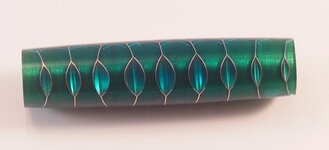Hi Cody - You may not have gotten what you wanted but you did get a great looking blank. I'm assuming that you are using Alumilite Clear with a 7 minute working time, I use that exclusively.
I pre-mix all of my colors completely with a little "A" resin in as many cups as colors to pour. So if I'm using 3 colors I'll have three cups with the color mixed before I mix the A+B. If I have a 15oz pour, with 10oz base color, 2.5oz accent color, then another 2.5oz for the third accent color I will have three cups of color mixed with a little "A" resin, then in a fourth cup mix the 7.5oz of A and the 7.5oz of B. I start my 7 minute timer, then I mix with a small paint mixer on a drill. After that 15oz A+B is mixed I'll pour off the amounts decided upon into the "color cups" and remix by hand to mix in the colors. Then after that I start pouring them all together in the mold. Due to the thermal activity of the resin setting it's hard to gauge how much mixing will go on.
I have found that more intense coloring helps to define or show differentiation better.
Consider painting your tubes if you don't want the transparency. There are a number of ways to go there, paint the same approximate color as your pour, go with black or white, or contrast your pour color.
I'd like to try some of that aluminum honeycomb, was it hard to acquire?
Happy turning - Tom


